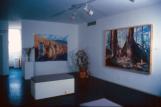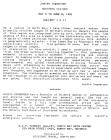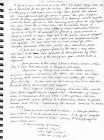1
Judith Ingwersen, the eldest of two children, was born in 1947 in North Bay, Ontario as Judith Elizabeth Ryerse. She was raised in North Bay.In 1966, she moved to Waterloo, Ontario, where she earned a Bachelor of Science in Mathematics and Physics from 1966 to 1969 from the Waterloo University College. From 1967 to 1969, she was a physics lab instructor. She received university faculty board scholarships as well as the grad medal in mathematics. In 1969, she moved to North Bay, where she worked for Cambrian College, which later became Canadore College.
In 1971, she married William Ingwersen, with whom she has two children.
From 1971 to 1998, she took courses in art, ceramics and printmaking at Canadore College in North Bay, and also at Canadore College, she was a lab technician from 1970 to 1972. From 1981 to 1985, she took fine arts courses at Nipissing University, which is adjacent to Canadore College. From 1985 to 1989, she was an instructor in math and science at Canadore College. From 1994 to 1998, she was the director and instructor of Nipissing Educational Services. In the summer of 1999 and 2000, she taught in the Artsperience program at Canadore College.
She served on the board of White Water Gallery in North Bay from 1999 to 2002.
Solo exhibitions of her work include: In a Dark Forest (2005), Retrospective (2004), Sealskin Woman (2003, White Water Gallery, North Bay, Ontario), Skeleton Woman (2002, White Water Gallery, North Bay, Ontario), Manitou Woman's Event (2001, Sudbury, Ontario), Songs of Nature (2000) Commingle (1999, Goderich, Ontario), From Ragged Edges (1999, White Water Gallery, North Bay, Ontario), Reception for the Queen (1998, Canadore College, North Bay, Ontario), Echoes of the Inner Landscape (1997, Joan Ferneyhough Gallery, North Bay, Ontario), Art in Public Places, North Bay Arts Centre (1993), The Society of Management Accountants (1992, Toronto, Ontario), The Spirit of the Bride Say Come (1992, St. Andrews United Church, North Bay, Ontario), Northern Visions (1991, W. K. P. Kennedy Gallery, North Bay, Ontario).
(The biographical information featured here was written in consultation with the artist in 2006.)
Interview:
PAINTER'S INSPIRATION COMES FROM THE WORLD
Judith Ingwersen was born to become an artist. The North Bay artist first discovered her lifelong passion when she was just a little girl. "From a very young child all I wanted to do was draw," Ingwersen said.
Ingwersen's artistic passion comes from the beauty all around us and from the beauty within us. "Whether that be landscape, relationships, and our need to embrace and protect the earth and its peoples," Ingwersen explained. In addition, personal and global effects play a major role in Ingwersen's work. "I am passionate about sharing my insights, peace and joy in spite of seeming disasters and destruction," Ingwersen added.
Ingwersen's ideas come from myths, stories, people and landscapes. "I respond to my experiences in the landscapes I find myself in and in my relationships with family and friends," Ingwersen said.
Ideas also come from movies, and spiritual experiences. "A whole series of my paintings came from dreams and they continue to inspire," Ingwersen said.
Before any drawings or paintings are started, Ingwersen conducts research through books, friends, and the Internet. Once the research has been completed, she will then work with some smaller drawings and paintings until she gets close to what she wants. "Sometimes I draw and then paint what is in my mind's eye with my eyes closed, or use blind contour to put on paper and canvas what I see," Ingwersen said.
Ingwersen's time spent on each piece varies in length. "Sometimes a small work takes months and a 9 inch one takes weeks," Ingwersen explained. "The blind contour ones are done in an hour or two, while one 16 inch work took six months."
All of Ingwersen's work depicts certain themes. "Freedom and spaciousness, joy and peace, our interconnectedness with everyone and everything and all of creation, underlie my work," Ingwersen said. "Healing and wholeness are thematic in all of the myths and stories." Someone once told Ingwersen that "life is all about healing the relationship with our mothers". She said, "Art is about healing all of our relationships and recognizing our profound interconnectedness with all and healing ourselves through accepting our connection to a divine source, within us and around us."
Ingwersen believes art inspires everyone.
(By Andrew Hopkins, based on an interview in winter, 2006).
3
Judith Ingwersen, Ragged Edges (installation view)1999
White Water Gallery, North Bay, Ontario, Canada



